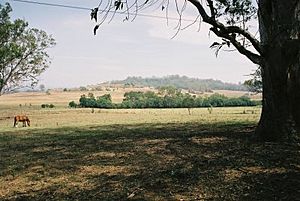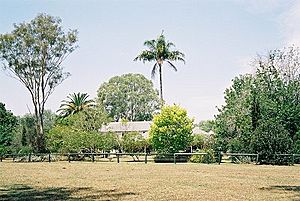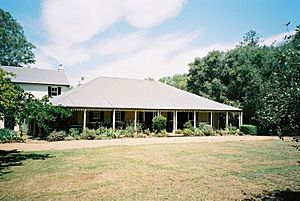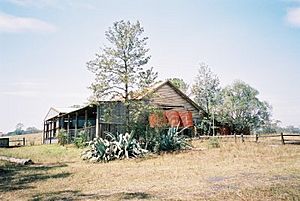Denbigh, Cobbitty facts for kids
Quick facts for kids Denbigh |
|
|---|---|
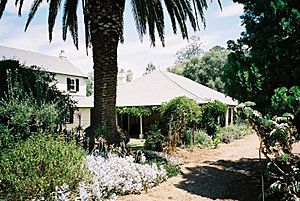 |
|
| Location | 421 The Northern Road, Cobbitty, Camden Council, New South Wales, Australia |
| Built | 1818 |
| Official name: Denbigh | |
| Type | state heritage (landscape) |
| Designated | 22 December 2006 |
| Reference no. | 1691 |
| Type | Farm |
| Category | Farming and Grazing |
| Builders |
|
| Lua error in Module:Location_map at line 420: attempt to index field 'wikibase' (a nil value). | |
Denbigh is a very old and important farm located in Cobbitty, a suburb in south-western Sydney, New South Wales, Australia. It started as a vineyard and later became a farm for special types of horses (Clydesdale) and cows (Ayrshire). Today, it's a farm that raises Hereford cattle. The main house was built in 1818. Denbigh is privately owned and is listed on the New South Wales State Heritage Register, which means it's a protected historic site.
Contents
History of Denbigh Farm
The first owner of Denbigh was a man named Charles Hook. He received this large piece of land, about 1,100 acres (445 hectares), from Governor Macquarie in 1812. Hook and his wife moved into their new house around 1822. He started clearing the land to grow crops. Charles Hook passed away in 1826.
By 1826, the farm was growing wheat and maize. There was a big house and other useful buildings. Before 1826, a small vineyard was planted on a hill, and a group of olive trees grew near the house. Aboriginal people also used the nearby paddocks for important ceremonies.
The Hassall Family Era
In 1826, a church leader named Thomas Hassall bought Denbigh. He began making the house bigger in 1827. It took over four years to finish the main house and other buildings. Thomas Hassall was an important person who had started Australia's first Sunday School for children in Parramatta.
Under Hassall's ownership, Denbigh was like a small village. It had its own school teacher, blacksmith, carpenter, and many other workers. The farm had beautiful gardens with fruit trees, a vineyard, and an orange grove. You could see churches in nearby Camden, Narellan, and Cobbitty from the hills.
Hassall also hired local Aboriginal people to help clear land for farming. Big Aboriginal ceremonies, called corroborees, were held on the Denbigh estate. In 1828, Hassall helped build Heber Chapel in Cobbitty. During this time, the farm grew wheat and wool, and had vineyards and orchards.
By 1845, fewer people were working at Denbigh. The farm buildings became smaller, similar to how they were in 1820.
Later Owners and Farm Changes
In 1866, a Scottish farmer named Charles McIntosh leased land at Denbigh. He bought the property the next year, after Thomas Hassall died. The McIntosh family used the farm to breed Clydesdale horses, which are large, strong horses.
From 1910, Denbigh became a dairy farm and raised Ayrshire cattle. Today, the McIntosh family still owns Denbigh, and it is now a farm that breeds Hereford cattle.
What Denbigh Looks Like
Denbigh is a large farm that still looks much like it did in the 1800s.
The Farm Area
The original land grant from 1812 is still mostly the same. The entrance gates are simple, and the road leads through fields and groups of eucalyptus trees. Many old trees from the 1800s are still there, including a line of tall forest red gums.
There are two other old cottages on the farm: Bangor and Cluny. Cluny cottage was moved from another spot on the farm to where it is now. There is also an old quarry on the farm.
The Gardens
A winding driveway goes through a second set of gates and into an area with many olive trees, shrubs, and vines. This area leads to the main house, which has a very neat and formal garden. The olive grove was planted before 1826 to provide shade.
The garden has many old and interesting plants. You can find a carob tree, a kurrajong tree, a Bunya Bunya pine, and peppercorn trees. Denbigh also has a cottage garden with old-fashioned roses and other plants popular in the 1800s. A unique cactus tree from South America stands between the house and other buildings.
In the summer, the garden smells wonderful with old roses like gallicas and damasks. Some of the first types of roses grown in Australia, called China roses, are also found here. A Mediterranean cypress tree on the east side of the garden was supposedly planted by Thomas Hassall himself.
The Main House
The main house is built on a spot that gives great views of the surrounding fields and hills. The house is made of timber with bricks inside the walls and covered with weatherboards. It has a sloped roof and a brick verandah supported by wooden posts. The chimneys are simple but have a colonial look. The house has been updated over the years, but it still keeps its old charm.
Outbuildings
In Thomas Hassall's time, Denbigh had many buildings that made it like a small village. These included a school, a blacksmith's shop, and a carpenter's workshop. Today, there are still farm buildings near the house, including old sheds made of timber slabs and a barn with thick stone walls. The barn even has Thomas Hassall's initials carved into the wood.
A very large forest red gum tree stands in the middle of the farm buildings, near the old coach house and stables. Further away, there are more old huts and sheds.
Why Denbigh is Important
Denbigh is very important because it's a great example of an early farm that has been used continuously since 1817. It still sits on its original land grant from 1812.
- History: It shows how farming was done in early New South Wales. It also has links to important people like Thomas Hassall and the McIntosh family.
- Looks: The farm has a special beauty with its old buildings, gardens, and views. The way the house and trees are placed shows how people designed landscapes in the 1800s.
- People: Denbigh is important because it was a place where Aboriginal people and European settlers met and interacted. It also has meaning for the families who have lived there for generations.
- Learning: Scientists can learn a lot from Denbigh about early European farming and Aboriginal life through studying the land.
- Rareness: It's rare to find such an old farm complex that is still mostly intact and has been used continuously for so long.
Denbigh was added to the New South Wales State Heritage Register on 22 December 2006.


